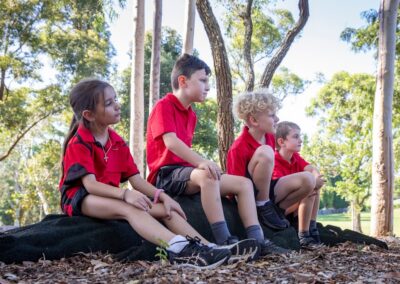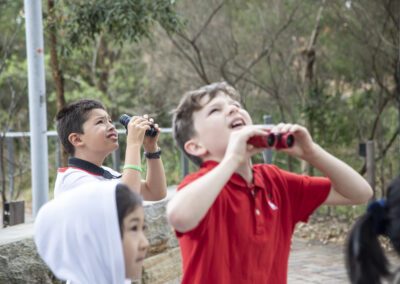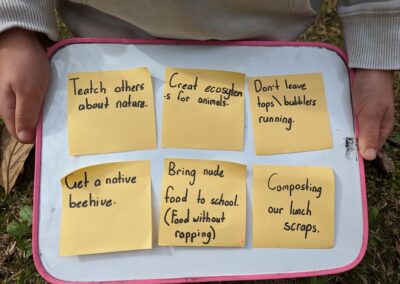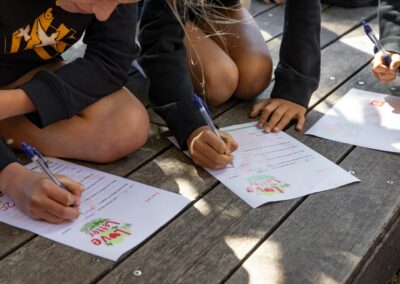
Love Letters to the Land
Time Allocation: 45 mins
Activity Level: Easy
Introduction
In this activity, you will invite your learners to connect with the natural features in your area – this could be in your schoolyard, eco-garden, local bushland or park etc.
The activity has been designed to help children think about why the land, the flora and fauna is important to them – and to identify a small action they can take to help protect, improve or enhance their local environment. Finally, this activity encourages learners to share their letters with a wider audience and promote caring for and protecting the environment on an ongoing basis.
If you need some inspiration, you can watch this video of Junior Landcare ambassador, Costa, speaking with students about why they love the environment and steps they are taking to care for it.
Checklist
Instructions
 Step 1
Step 1
Head outside
Find an area that enables the opportunity to sit and have quiet reflection. Ensure learners are able see, hear and take in some form of nature at this location; for urban areas, this could be as simple as sitting under a tree or alongside a veggie patch.
Begin this activity with an Acknowledgement of Country.
Mention the Traditional Owners of the land and the Country you are on. If you are not sure of the Country you’re on, use the AIATSIS interactive tool.
Explain to your learners that today they are going to be writing a love letter to the land; but to do this we need to take the time to quietly observe, consider and reflect. To do this, we will take some time to sit quietly and then share; this will help inspire our writing.
 Step 2
Step 2
Observe
Tell your learners that they will be observing the natural world around them. Discuss what this could mean. It could include:
- Trees, plants and flowers (flora)
- Animals e.g. birds, insects, etc. (fauna)
- Natural features e.g. rocks, soil, creeks, etc.
Explain how we can engage our senses to make observations. For example, ask learners if they can:
- Hear the wind in the trees or calls of birds
- See roots in the soil or the shade of a tree
- Smell the earth, leaves or flowers
- Feel the ground under their feet or cool breeze from the trees.
Conduct your observation.
 Step 3
Step 3
Share, consider and reflect
Sit in a circle (you may like to refer to our Yarning Circle Activities for background and inspiration to set up a yarning circle) and share your observations.
As the children share, record their observations on the post-it notes.
Discuss with your learners how they think the land has changed in the last few hundred years. Point out how the trees, gardens and other natural features that you just observed have been planted, protected and enhanced by others, and that the small action of planting a tree many years ago gives us shade to sit under now.
Ask your learners what small actions each of us can do that would help the land now and into the future.
Reflect on these small actions and discuss how, once they are all combined, these actions can make a big difference. Record the responses on the different coloured post-it notes.
Challenge generalised notions such as ‘I won’t litter’ or ‘I won’t pollute’ or ‘I won’t waste water’. Ask the children what specific actions they can take. For example, ‘I will wrap my lunch in reusable covers like beeswax wraps, not plastic.”
 Step 4
Step 4
Write and share
Head back inside (or if it is a nice day, stay outside and use the clipboards to lean on). Distribute the Love Letter templates. You can choose from a pre-filled template for younger learners or a blank template for older students.
Invite children to complete their Love Letter to the Land. For older students, encourage them to elaborate their ideas with explanations. For younger learners, you can use the pre-filled template with sentence starters. Download here.
As a group, share your letters.
Then ask your learners: What should we do with our letters and our ideas about how we can help the land?
Ideas could include:
– Make an action plan to implement some of the ideas in your school
– Make a time capsule and bury your letters for future generations of students to read
– Send your letters to your local Member of Parliament
– Send your letters to a sister school and ask them to share with you what they love about their local environment and steps they are taking to care for it.
– Publish your Love Letters in the school newsletter or share them with local media.
– Present them at your school assembly.
– Send them to Junior Landcare for Costa to read, here.
Extension Activity
Research how the landscape and land use has changed in the last 200 years in your area.
Research how First Nations people have cared for and continue to care for Country in your area.